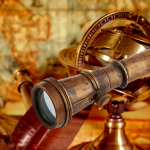Pilgrims as the Unlikely Early Optics Innovators
Before There Was an Optics Valley
When we think about optics today, we often envision modern tech hubs like Optics Valley leading the way, with innovations such as lasers, sensors, telescopes, and photonics. But long before America had research labs or precision-polishing facilities, the very first European settlers were already using sunlight, glass, lenses, and navigation tools to survive, explore, and understand a new world.
Surprisingly, the Pilgrims who arrived in 1620 played a quiet but essential role in bringing early optical technology to North America. They were not scientists in the modern sense, but they depended on tools that used light, lenses, and solar measurements for everything from navigation to fire-starting. In many ways, they became some of America’s earliest “optics innovators,” using the science of light long before the country even existed.
Crossing an Ocean With Light and Optics
The Pilgrims’ journey across the Atlantic was only possible because of early optical navigation. Sailors of the time didn’t have GPS, computers, or detailed maps. Instead, they used the sun, the stars, and a set of optical instruments to determine their location.
On board the Mayflower were navigation tools like:
- Cross-staffs – instruments that used angles of sunlight to calculate latitude.
- Astrolabes – devices combining geometry and sunlight to measure position.
- Quadrants – tools that relied on the height of the sun above the horizon.
- Spyglasses – early telescopes that helped sailors scan the horizon.
These instruments didn’t just guide the Pilgrims; they introduced the first practical optical technologies to North America. Every reading taken at sea depended on light passing through an instrument, reflecting calmly off a brass scale, or being sighted through a small glass lens.
Without these early optical tools, the Pilgrims would never have reached New England.
Magnifying Lenses: Small Tools, Big Innovation
When the Pilgrims arrived in the harsh New England environment, survival depended on their ability to work with limited resources. One of their most essential tools was also one of the simplest: the magnifying lens.
Magnifying lenses helped them:
- Read and copy essential documents
- Identify seeds, plants, and pests
- Inspect small objects with more detail
- Start fires by focusing sunlight on dry tinder
This last use, concentrating sunlight to start a fire, was more than clever. It represented early solar technology. By using a convex lens to collect heat onto a single point, they were essentially performing a primitive version of solar concentration, a concept used today in solar power engineering.
These tools made the Pilgrims early adopters of portable optics in North America.
Solar Timekeeping in a New Land
In England, the Pilgrims had access to church bells and early clock towers to keep time. In the wilderness of America, they had none of that. Instead, they used the oldest time-keeping instrument humanity has: the sun.
The Pilgrims and other settlers used pocket sundials and simple gnomons (sticks placed in the ground) to measure the hours of the day. They used shadows to decide when to begin work, when to gather for community events, and when to prepare for nightfall.
The sundial might seem straightforward today, but in the 1600s it was a clever piece of optical engineering using the sun’s position and the geometry of shadows to create a reliable, “solar-powered” clock.
Glassmaking and Light in the New World
The Pilgrims also contributed to the early development of glass in America. While they did not invent glassmaking, they helped support some of the continent’s earliest attempts to produce:
- Window glass
- Bottles
- Lantern covers
- Simple lenses
This mattered because glass was the foundation of more advanced optics. Without early colonial glassmaking, America would not have progressed toward later breakthroughs in telescopes, microscopes, and precision optics, which centuries later would lead to places like Optics Valley.
Lanterns and Early Optical Reflection
Lighting a home in the 1600s was difficult and dangerous, but Pilgrims brought an innovation of their time: tin lanterns with reflective sides. These lanterns used small, polished metal reflectors to direct candlelight more efficiently. This was a basic application of optical reflection, one of the key principles behind modern lighting, lasers, and imaging systems.
In a world without electricity, this improvement made a huge difference. It allowed Pilgrims to work safely at night, move through their settlements in the dark, and extend their productive hours.
The First Step Toward America’s Optics Future
The Pilgrims were not scientists the way we imagine today, nor were they building telescopes or lasers. But they did bring and adapt the earliest forms of optical innovation to North America. They depended on sunlight, lenses, reflectors, and optical measurements in ways that shaped their survival and progress.
Their story shows something important:
America’s journey with optics didn’t begin in a lab; it started with explorers, settlers, and innovators solving real problems with the science of light.
Long before Optics Valley existed, the Pilgrims were already lighting the way.








